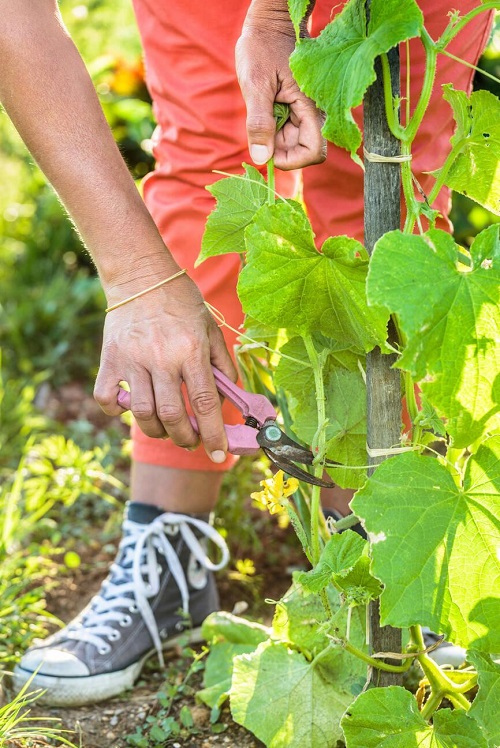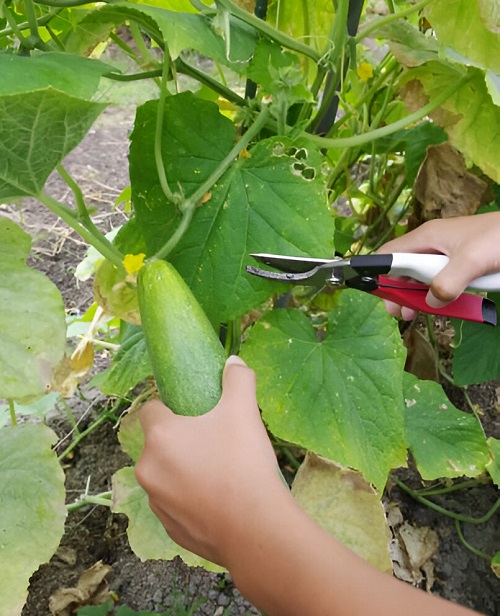We’ve got everything you need to know to Prune Cucumber Plants to Get More Juicy Cucumbers! What are you waiting for? Read on!

After all that hard work, a bad harvest can spoil your mood. Not anymore, though; with these tips and tricks on pruning cucumbers for a juicy harvest, you’ll have plenty of these veggies, and that too, really good ones!
Do Cucumbers Need Pruning?
Cucumber plants in the wild grow on their own, and no one prunes them. But it’s different since they grow for survival, and producing fruit isn’t all that necessary. So yes, cucumber plants do need pruning if you want a flavorful and bountiful harvest.
Benefits of Pruning Cucumber Plants
- Reduced Risk of Fungal Disease: With manageable growth and leaves, there is more air circulation, which allows the plant to remain fresh and free from diseases.
- Better Fruits & Efficient Growth: By removing suckers and non-productive vines, the plant channels all its energy into producing fruit instead of foliage, leading to a richer harvest.
- No Hiding in Shade: Reduced foliage means that sunlight can reach spots that usually would’ve been in the shadows of the leaves. Sunlight is important for the growth of cucumbers.
- No More Spread of Diseases: if pruned at the right time, infected foliage and other parts of the plant can be easily separated, thus reducing the spread of the disease or infection throughout the entire plant.
- Easy to Care: An unkempt plant is hard to maintain. If regularly pruned, the cucumber plant’s size and spread can be controlled, allowing better care of the plant as a whole.
Note: Infected, stressed, recovering, and recently transplanted plants should not be pruned until they reach a healthier and more stable stage.
How to Prune Cucumber Plants to Get More Juicy Harvest
For a robust cucumber harvest, pay attention to and follow these pruning methods in the order they are mentioned.
1. Sucker Pruning
Suckers really do suck, slowly usurping and diverting the energy of the plant for their own growth instead. They are the small shoots that grow from the leaf axils (angle between the leaf and the stem) or from the base of the plant, usually around the lower parts of plant, just like tomatoes, and they never produce flowers or fruits!
Monitor their emergence constantly, and once you spot a few, trim them off when they are young.
2. Selective Pruning
Pruning reduces the spread of diseases within the plant. If you find a damaged or infected leaf, stem, or fruit, spring into action and quickly sever using a sharp pruning shear.
Only snip away the affected plant part, and do not overdo it. Don’t get carried away and snip off more than needed.
3. Pinching the Top
You can do this twice, once when your cucumber plant is young and 12 to 18 inches high, by pinching or removing the top growing tip of the plant just a little above the first leaf node. This will promote more side growth and a stronger root system.
Another would be a later pruning when your cucumber plant becomes 5 to 7 feet tall; cut off the main stem again just above the first leaf node you identify to encourage the vertical growth of the vine.
4. Lateral Pruning
Now that we’ve ensured lateral growth, what if your plant gets too wide and grow a lot of side shoots? This can also hinder the plant’s ability to produce the best-quality cucumbers. Here’s what to do.
Once it reaches a reasonable width, start cutting off the extra vines or leaves to ensure that the plant is not overburdened with foliage. Allow it to reach a width of 12-18 inches before any kind of lateral pruning.
5. Trellis Pruning
Many gardeners use trellis support to control the growth and structure of their cucumber plants. If you are one of them, this pruning step is for you!
To ensure that the plant stays in the designated position and does not grow over the required space, prune away the excess lateral or top growth, keeping it contained and stable on the trellis.
When is the Best Time to Prune the Cucumber Plant?
You can start pruning by pinching the top growth using your fingernails as early as when the plant shows 4-6 true leaves, you can prune again when it is 12-18 inches tall.
In most cases, prune when the plant begins to produce flowers and has established a strong root system.
Bush varieties don’t need pruning as much as vines, so prune them occasionally.
Additional Tips for Pruning Cucumber
Observe your cucumber plant throughout the growing season. If you notice a sudden decrease in flower production, maybe you pruned too heavily, which is anything more one-third of the plant any any single time. Ease off causing any stress to your plant for a while, and allow it to recover.
And remember to use sterilized pruning tools. Thoroughly clean your shears or scissors, as contaminated tools may spread disease and do more harm than good.
Your plant needs to rest and recover after pruning. Avoid pruning during extreme weather or unfavorable environmental conditions, as the plant may undergo extreme stress trying to survive.
Your plants need sufficient water, sunlight, rich soil, and nutrients for optimal growth and fruit production. With the right love and attention, your cucumbers will be rocking a delicious harvest in no time! If this worked for you, don’t forget to share your experiences via the comments section below!



